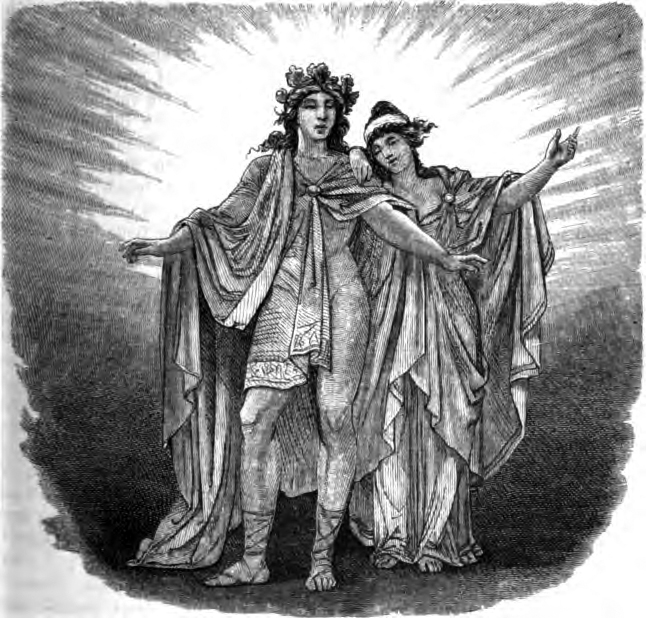|
Móðguðr
In Norse mythology, Móðguðr (Old Norse: , "Furious Battler"; also Modgud) refers to the female guardian of the bridge over the river Gjöll ("Noisy"), Gjallarbrú. She allowed the newly dead to use the bridge to cross from one side of the river Gjöll to the other if the soul stated their name and business and possibly in turn prevented the dead beyond the river from crossing back over Gjöll into the lands of the living. ''Gylfaginning'' In the book ''Gylfaginning'' at the end of Chapter 49, the death of Baldr and Nanna (Norse deity), Nanna is described. Hermóðr, described as Baldr's brother in this source, sets out to Hel on horseback to retrieve the deceased Baldr. To enter Hel, Hermóðr rides for Numbers in Norse mythology, nine nights through "valleys so deep and dark that he saw nothing" until he arrives at the river Gjöll ("Noisy") and its bridge, Gjallarbrú, which is guarded by Móðguðr. The bridge is described as having a roof made of shining gold. Hermóðr cross ... [...More Info...] [...Related Items...] OR: [Wikipedia] [Google] [Baidu] |
Hermóðr
Hermóðr (Old Norse: , " war- spirit";Orchard (1997:83). anglicized as Hermod) is a figure in Norse mythology, a son of the god Odin and brother of Baldr. Attestations ''Prose Edda'' Hermóðr appears distinctly in section 49 of the '' Prose Edda'' book '' Gylfaginning''. There, it is described that the gods were speechless and devastated at the death of Baldr, unable to react due to their grief. After the gods gathered their wits from the immense shock and grief of Baldr's death, Frigg asked the Æsir who amongst them wished "to gain all of her love and favor"Byock (2005:66). by riding the road to Hel. Whoever agreed was to offer Hel a ransom in exchange for Baldr's return to Asgard. Hermóðr agreed to this and set off with Sleipnir to Hel. Hermóðr rode Odin's horse Sleipnir for nine nights through deep and dark valleys to the Gjöll bridge covered with shining gold, the bridge being guarded by the maiden Móðguðr 'Battle-frenzy' or 'Battle-tired'. Móðguðr told ... [...More Info...] [...Related Items...] OR: [Wikipedia] [Google] [Baidu] |
Gjöll
Gjöll (Old Norse: ''Gjǫll'' ) is the river that separates the living from the dead in Norse mythology. It is one of the eleven rivers traditionally associated with the Élivágar, rivers that existed in Ginnungagap at the beginning of the world. According to Snorri Sturluson's ''Gylfaginning'', Gjöll originates from the wellspring Hvergelmir in Niflheim, flowing through Ginnungagap, and thence into the worlds of existence. Gjöll is the river that flows closest to the gate of the underworld. Within the Norse mythology, the dead must cross the Gjallarbrú, the bridge over Gjöll, to reach Hel. The bridge, which was guarded by Móðguðr, was crossed by Hermóðr during his quest to retrieve Baldr from the land of the dead. In ''Gylfaginning'', Gjöll is one of eleven rivers that rise from Hvergelmir. In the following chapter, these are called the Élivágar and are said to have flowed in Ginnungagap in primordial times. Gjöll has a parallel with similar mythological rive ... [...More Info...] [...Related Items...] OR: [Wikipedia] [Google] [Baidu] |
Gjallarbrú
In Norse mythology, Gjallarbrú ( lit. "bridge of Gjöll") is a bridge that crosses the river Gjöll, serving as the passage to reach Hel.''Norse Mythology: A Guide to Gods, Heroes, Rituals, and Beliefs'' (John Lindow, author. Oxford University Press, 2002, page 142) It figures most prominently in Snorri Sturluson's Gylfaginning, in the section of the Baldr Baldr (Old Norse also Balder, Baldur) is a god in Germanic mythology. In Norse mythology, he is a son of the god Odin and the goddess Frigg, and has numerous brothers, such as Thor and Váli. In wider Germanic mythology, the god was known in ... myth describing the journey of Hermód to Hel in an attempt to retrieve Baldr. After riding nine nights through deep and dark valleys, he comes to the bridge, and there he has a conversation with Módgud, the maiden who guards the bridge. She asks Hermód his name and family and informs him that five troops of dead men rode over the bridge the day before, but the bridge shake ... [...More Info...] [...Related Items...] OR: [Wikipedia] [Google] [Baidu] |
Norse Mythology
Norse, Nordic, or Scandinavian mythology, is the body of myths belonging to the North Germanic peoples, stemming from Old Norse religion and continuing after the Christianization of Scandinavia as the Nordic folklore of the modern period. The North Germanic languages, northernmost extension of Germanic mythology and stemming from Proto-Germanic folklore, Norse mythology consists of tales of various deities, beings, and heroes derived from numerous sources from both before and after the pagan period, including medieval manuscripts, archaeological representations, and folk tradition. The source texts mention numerous gods such as the thunder-god Thor, the Huginn and Muninn, raven-flanked god Odin, the goddess Freyja, and List of Germanic deities, numerous other deities. Most of the surviving mythology centers on the plights of the gods and their interaction with several other beings, such as humanity and the jötnar, beings who may be friends, lovers, foes, or family members of ... [...More Info...] [...Related Items...] OR: [Wikipedia] [Google] [Baidu] |
Old Norse
Old Norse, also referred to as Old Nordic or Old Scandinavian, was a stage of development of North Germanic languages, North Germanic dialects before their final divergence into separate Nordic languages. Old Norse was spoken by inhabitants of Scandinavia and their Viking expansion, overseas settlements and chronologically coincides with the Viking Age, the Christianization of Scandinavia, and the consolidation of Scandinavian kingdoms from about the 8th to the 15th centuries. The Proto-Norse language developed into Old Norse by the 8th century, and Old Norse began to develop into the modern North Germanic languages in the mid- to late 14th century, ending the language phase known as Old Norse. These dates, however, are not precise, since written Old Norse is found well into the 15th century. Old Norse was divided into three dialects: Old West Norse (Old West Nordic, often referred to as ''Old Norse''), Old East Norse (Old East Nordic), and Old Gutnish. Old West Norse and O ... [...More Info...] [...Related Items...] OR: [Wikipedia] [Google] [Baidu] |
Gylfaginning
''Gylfaginning'' (Old Norse: 'The Beguiling of Gylfi' or 'The Deluding of Gylfi'; 13th century Old Norse pronunciation ) is the first main part of the 13th century ''Prose Edda'', after the initial Prologue. The ''Gylfaginning'' takes the form of a dialogue between a Swedish King Gylfi and three men on thrones in Asgard called High, Just-As-High, and Third. Gylfi asks many questions of the three men on the history and future of the Æsir. The creation and eventual destruction of the world are described, as are many other aspects of Norse mythology. While the Gylfaginning never makes it explicit, the three are often presumed to be guises of Odin. The second part of the ''Prose Edda'' is the ''Skáldskaparmál'' and the third ''Háttatal''. The work is often attributed to or considered to have been compiled by Snorri Sturluson. Summary The ''Gylfaginning'' tells the story of Gylfi, a king of "the land that men now call Sweden". He is tricked by one of the goddesses of th ... [...More Info...] [...Related Items...] OR: [Wikipedia] [Google] [Baidu] |
Nanna (Norse Deity)
In Norse mythology, Nanna Nepsdóttir (Old Norse) or simply Nanna (Old Norse) is a goddess associated with the god Baldr. Accounts of Nanna vary greatly by source. In the ''Prose Edda'', written in the 13th century by Snorri Sturluson, Nanna is married to Baldr and the couple produced a son, the god Forseti. Mythology After Baldr's death, Nanna dies of grief. Nanna is placed on Baldr's ship with his corpse and the two are set aflame and pushed out to sea. In Hel (location), Hel, Baldr and Nanna are united again. In an attempt to bring back Baldr from the dead, the god Hermóðr rides to Hel (location), Hel and, upon receiving the hope of resurrection from the goddess Hel (being), Hel, Nanna gives Hermóðr gifts to give to the goddess Frigg (a robe of linen), the goddess Fulla (a finger-ring), and for others (unspecified). Nanna is frequently mentioned in the poetry of skalds and a Nanna, who may or may not be the same figure, is mentioned once in the ''Poetic Edda'', compil ... [...More Info...] [...Related Items...] OR: [Wikipedia] [Google] [Baidu] |
Numbers In Norse Mythology
The numbers 3, three, 9, nine, and other multiples of three are significant numbers in Germanic paganism. Both numbers (and multiples thereof) appear throughout surviving attestations of ancient Germanic folklore, in both mythology and Germanic paganism.. Along with the number 27, both numbers also figure into the lunar calendar, lunar Germanic calendar. Examples Emphasis on the numbers three, nine, and multiples of three occur frequently in the ancient Germanic record. Examples include: West Germanic ''Old English'' *''Æcerbot'': A charm that describes a ritual wherein the speaker should bow nine times to the east. *''Nine Herbs Charm'': A charm focused on nine plants, using the number nine extensively and featuring the Old English extension of the Germanic god Odin. ''Old High German'' * Merseburg Charms: Two Old High German charms stemming from the pagan period mentioning at least six pagan Germanic deities and other beings. According to Patricia Giangrosso, "the second Mers ... [...More Info...] [...Related Items...] OR: [Wikipedia] [Google] [Baidu] |
Penguin Classics
Penguin Classics is an imprint (trade name), imprint of Penguin Books under which classic works of literature are published in English language, English, Spanish language, Spanish, Portuguese language, Portuguese, and Korean language, Korean among other languages. Literary critics see books in this series as important members of the Western canon, though many titles are translated or of non-Western origin; indeed, the series for decades since its creation included only translations, until it eventually incorporated the Penguin English Library imprint in 1986. The first Penguin Classic was E. V. Rieu's translation of ''The Odyssey'', published in 1946, and Rieu went on to become general editor of the series. Rieu sought out literary novelists such as Robert Graves and Dorothy Sayers as translators, believing they would avoid "the archaic flavour and the foreign idiom that renders many existing translations repellent to modern taste". In 1964 Betty Radice and Robert Baldick succee ... [...More Info...] [...Related Items...] OR: [Wikipedia] [Google] [Baidu] |
Norse Underworld
Norse is a demonym for Norsemen, a Medieval North Germanic ethnolinguistic group ancestral to modern Scandinavians, defined as speakers of Old Norse from about the 9th to the 13th centuries. Norse may also refer to: Culture and religion * Norse mythology * Norse paganism * Norse art * Norse activity in the British Isles * Vikings Language * Proto-Norse language, the Germanic language predecessor of Old Norse * Old Norse, a North Germanic language spoken in Scandinavia and areas under Scandinavian influence from c. 800 AD to c. 1300 AD ** Old West Norse, the western dialect of Old Norse, spoken in Norway and areas under Norwegian influence *** Greenlandic Norse *** Norn language, an extinct North Germanic language that was spoken in Shetland and Orkney, off the north coast of mainland Scotland, and in Caithness ** Old East Norse, the eastern dialect of Old Norse, spoken in Denmark, Sweden and areas under their influence Location * Norse, Texas, a ghost town founded by No ... [...More Info...] [...Related Items...] OR: [Wikipedia] [Google] [Baidu] |


